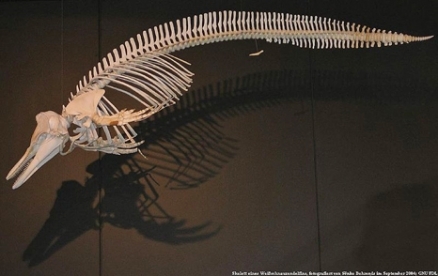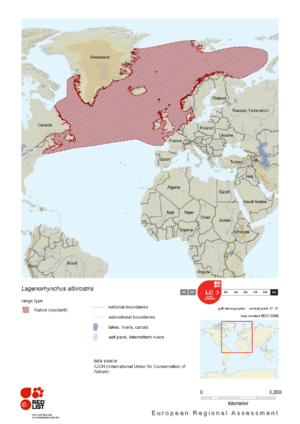White-beaked dolphin
The White-beaked dolphin (Lagenorhynchus albirostris) is an extremely active, fast-swimming species. They often ride the bow of boats and may be seen breaching (leaping out of the water and landing back in the water with a splash) or clearing the water when swimming fast. This cetacean is a social species that forms groups of between one to 35 individuals, but occasionally groups of up to 1500 have been observed. It feeds on schooling fish, crustaceans and cephalopods. A single calf is born in summer, measuring 1.2 metres in length at birth. A range of vocalisations including bursts of clicks and squeals are used to communicate, and may also be important in detecting prey and navigation. This marine mammal is a member of the family of Oceanic Dolphins, part of the order of [[cetacean]s].
| Conservation Status; Least Concern |
|
Scientific Classification Kingdom: Anamalia (Animals) |
Contents
Physical description
Despite the common and Latin names (albirostrismeans 'white beak'), the short, stocky beak of the white-beaked dolphin is not always white. It may be black and white, grey and white, completely white or even black in colour in certain parts of the range. This large dolphin has a rotund body, with a high dorsal fin placed in the centre of the back, behind which there is a characteristic greyish white patch that allows this species to be easily identified. The back, tail and flippers are black or grey in colour, and the belly is white or pale grey
The white-beaked dolphin has a robust body, with a short, thick beak about five to eight centimetres long in adults. The beak is distinctly set off from the melon. The dorsal fin is at mid-body. It is proportionally large (up to 15% of body length), often rounded at the peak, and strongly recurved. Both the dorsal fin and the flukes apparently decrease in size relative to other body dimensions as the dolphin ages. The pointed flippers can be up to 19% of the total adult length. The thickened tail stock tapers gradually, in marked contrast to that of theAtlantic white-sided dolphin.
The colouration of this species shows considerable variability. The beak of most white-beaked dolphins is white, often mottled with light grey or with greyish or blackish spots, but in some, it is almost entirely grey (though paler than the head). The dark dorsal field anterior to the dorsal fin is sometimes separated from the dark melon by a transverse light grey stripe, a brownish-grey patch or a bold whitish "chevron" around and behind the blowhole. It may extend downwards from the melon to encircle the eye. In front of the dark grey zones on the sides, there is a paler grey, rather ill-defined thoracic patch. Above and behind this patch, between the dark grey dorsal and lateral fields, the body is varying shades of light grey to nearly white. The whitish or light grey flank pigmentation extends dorsally onto the back behind the dorsal fin. The underside is white, with the white central part of the abdomen forming a narrow band between two pale grey patches. The flukes, the tail stock immediately in front of the flukes, and the flippers, are generally dark, but often spotted or marbled with white near the insertions of the flippers and on the undersides of the flukes. Four to six hair follicles are present on each side of the upper jaw. Hairs are present on the upper lip of young individuals.
Diagnostic identification characteristics include a robust body, with a short, thick beak about five to eight cm long in adults. The beak is distinctly set off from the melon. Both the dorsal fin and the flukes apparently decrease in size relative to other body dimensions as the dolphin ages. The thickened tail stock tapers gradually. The beak of most white-beaked dolphins is white, often mottled with light grey or with greyish or blackish spots, but in some it is almost entirely grey (though paler than the head). The dark dorsal field anterior to the dorsal fin is sometimes separated from the dark melon by a transverse light grey stripe, a brownish-grey patch or a bold whitish "chevron" around and behind the blowhole that may extend downwards from the melon to encircle the eye.
White-beaked dolphins are rather large, robust dolphins. The back is dark grey and black, with a lighter ‘saddlespot’ behind the dorsal fin. A dark grey to whitish line can be found above the eye which continues over the flanks to the anus. The colour is highly variable. The body is fairly stocky. The beak is rather short and the flippers are large and pointed.
Reproduction
Calves are born between June and September. At birth they are about 115 cm long and weigh 40 kg. They reach sexual maturity at a length of 1.95 m.
Behaviour
These dolphins are mostly found living far offshore, normally in shoals of six to 20 metres (m) in depth, although in one exceptional case the species is found feeding in waters of more than 1500 m. They are often observed together with the Atlantic white-sided dolphin. They are powerful swimmers who enjoy surfing on bow waves of ships.
Group size is generally one to 35 individuals, with occasional herds of several hundred, although a group as large as 1500 has been reported. Such large groups are exceptional, however, and probably consists of many smaller subgroups. White-beaked dolphins frequently ride the bow and stern waves of vessels. They are acrobatic at the surface, often leaping vertically from the water. They seem attracted to small boats, and this can bias the results of vessel surveys.
Distribution
This dolphin Inhabits northern oceans, the distribution reaches north to Iceland, the Greenland Sea and around central-west Greenland, but the species is rarely seen further south than Britain and Ireland. It is common in UK and Irish waters, most often seen in the central and northern North Sea to northwest Scotland, but it also occurs less frequently in southern Ireland, the western English Channel, and the Irish Sea. This species is most common in UK waters between June and September, but it is present throughout the year in northern British waters, the Baltic Sea, Belgian Exclusive Economic Zone, British Isles, Dutch Exclusive Economic Zone, European waters (ERMS scope), Faeroes, French Exclusive Economic Zone Part, Greenlandic Exclusive Economic Zone, Gulf of Maine, Hebrides, Icelandic Exclusive Economic Zone, Kattegat, Mediterranean Sea, North Sea, North West Atlantic, Northern North Atlantic, Norwegian Exclusive Economic Zone, Oostende, Orkney, Polish Exclusive Economic Zone, Portugese Exclusive Economic Zone, Scotland, Shetlands, Skagerrak, Southern Bight, Spanish Exclusive Economic Zone, Spanish Exclusive Economic Zone Part, United Kingdom Exclusive Economic Zone, West Mediterranean Sea, Wimereux.
Habitat
Lagenorhynchus albirostrisgenerally occurs in cool waters. This species moves north into Davis Strait during the spring and summer, then moves back in the autumn and spends the winter as far south as Cape Cod.
The White-beaked dolphin prefers cool waters, and spends most of the year in deep offshore waters, but may move closer to shore in summer. It is found widely over the continental shelf, but especially along the shelf edge.
Feeding habits
White-beaked dolphins feed on living, benthic, shallow water fish. Their food varies according to the region and probably depends on the local availability. The stomach content of those washed ashore at the Belgian coast consisted amongst others of whiting, cod, haddock, hake, herring, plaice, mackerel and cephalopods and some benthic crustaceans.
The principle prey of the white-beaked dolphin includes clupeids, gadids and hake. Other fish, squid, octopus and benthic crustaceans are also eaten.
Conservation status
Classified as Least Concern (LC) on the IUCN Red List. Listed on Annex IV of the EC Habitats Directive, Appendix II of the Bonn Convention (North and Baltic Sea populations) and Appendix II of the Bern Convention. All cetaceans (whales and dolphins) are listed on Annex A of EU Council Regulation 338/97; they are therefore treated by the EU as if they are included in CITES Appendix I, so that commercial trade is prohibited. In the UK all cetaceans are fully protected under the Wildlife and Countryside Act, 1981 and the Wildlife (Northern Ireland) Order, 1985.
A United Kingdom Biodiversity Action Plan priority species, the white-beaked dolphin is protected in UK waters by the Wildlife and Countryside Act 1981 and the Wildlife (Northern Ireland) Orders, 1985; it is illegal to intentionally kill, injure, or harass any cetacean (whale or dolphin) species in UK waters. The Agreement on the Conservation of Small Cetaceans in the Baltic and North Seas (ASCOBANS) has been signed by seven European Countries, including the UK. Provision is made under this agreement to establish protected areas, promote research and monitoring, water pollution control and increase public awareness.
Threats
Known threats include environmental changes and the risk of entanglement in fishing nets (bycatch) and subsequent suffocation. White-beaked dolphins are hunted along the coasts of several Northern Atlantic countries including Norway, Iceland and Newfoundland. Like other North Atlantic marine mammals, white-beaked dolphins are poisoned by organochlorides, other herbicides and anthropogenic compounds, and heavy metals. The impact of these factors on the population are unknown. Some populations have apparently grown in the last thirty years or so, while others (including those in the Gulf of Maine) have declined.
References
- Encyclopedia of Life. 2010. Lagenorhynchus albirostris
- W. Perrin. 2011. Lagenorhynchus albirostris (Gray, 1846). In: Perrin, W.F. World Cetacea Database. Accessed through: Perrin, W.F. World Cetacea Database on 2011-02-08
- IUCN Red List
- Stienen, E.W.M.; Van Waeyenberge, J.; Kuijken, E. (2003). Zeezoogdieren in Belgisch mariene wateren [Marine mammals in Belgian marine waters]. Rapport Instituut voor Natuurbehoud, A.2003.152. Instituut voor Natuurbehoud: Brussel, Belgium. 15 pp.
- Carwardine, M., Hoyt, E., Fordyce, R.E. and Gill, P. (1998) Whales and Dolphins, the Ultimate Guide to Marine Mammals. Harper Collins Publishers, London.
- WDCS (June, 2002)
- Animal Diversity Web (June, 2002)
- Nishiwaki, M. 1972. General Biology. Pp. 3-204 in S. Ridgway, ed. Mammals of the Sea: Biology and Medicine. Springfield, IL: Thomas Books.
- Nowak, R. 1999. Walker's Mammals of the World. Baltimore and London: The John Hopkins University Press.
- Reeves, R., C. Smeenk, C. Kinze, R. Brownell, Jr., J. Lien. 1999. White-beaked Dolphin. Pp. 1-30 in S. Ridgway, R. Harrison, eds. Handbook of Marine Mammals, Vol 6. London: Academic Press.
- Shetland Wildlife, 1999. "Shetland Wildlife-News & Information on the Wildlife of Shetland" (On-line). Accessed December 10, 1999.
- Carwardine, M. (1995) Whales, Dolphins and Porpoises. Dorling Kindersley, London.
- D.Burnie. 2001. Animal. Dorling Kindersley, London.



